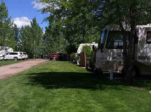Miywasin Moment: Haunting history unveiled at Native American museum
By JoLynn Parenteau on March 23, 2022.
Going Home, 1992, acrylic on canvas by artist Judith Lowry depicts the artist's great-aunt, 11-year-old Molly Lowry, who escaped California's Greenville Indian School in 1916. She died of exposure in the snowy woods.--PHOTO BY JOLYNN PARENTEAU
The Miywasin Moment presents Part 2 in a series of Native American history gleaned from the columnist’s travels.
“[Boarding schools] were started to stamp out the Indian from the Indian, [to] make us all into white people, and it didn’t work. Actually … it was the exact opposite: it made us stronger as Indian People. It made us more aware of and more proud of who we were.”
– Ruthe Blalock Jones (Delaware/Shawnee/Peoria)
PHOENIX, Ariz. -Internationally acclaimed Native American museum, the Heard, spans more than 130,000 square feet and is a marvel to visit, with main-floor galleries and outdoor courtyards displaying priceless art, clothing and depictions of robust cultural life.
The second-floor gallery however, is reserved for a much more sobering exhibit.
Away From Home: American Indian Boarding School Stories brings to light some of the darkest history of Turtle Island (Native North America): the harsh realities of residential schools in scenes not depicted anywhere in Canada.
In the 19th century, extreme changes were imposed on Turtle Island’s Indigenous Peoples. As settlers claimed more land, tribes were forcibly removed from their traditional homelands and pushed onto reservations. In 1881, U.S. Indian Affairs Commissioner Carl Schurz estimated it cost nearly $1 million to kill an Indian in warfare, while it cost only $1,200 to enrol an Indian child for eight years of schooling. Education was hailed as the tool to “civilize” the “savages.” The United States opened 365 boarding schools in 29 states.
Phoenix Indian Industrial School was established in 1891, marketed to the community as an economic boost, supplying pupils as cheap labour for farms and orchards during breaks in studies. The school first opened with 40 local Akimel O’otham and Pee Posh Tribe children. Just nine years later, in 1900, Phoenix Indian School housed more than 700 students, soon becoming the second largest Indigenous boarding school of its time. Parents who refused to enrol their children had government food rations withheld, and police forcibly abducted children.
“When you first started attending school, they looked at you, guessed how old you were, set your birthday, and gave you an age. Then they’d assign you a Christian name. Mine turned out to be Fred.”
– Fred Kabotie (Hopi), 1900, boarding school survivor
The Heard’s Away From Home gallery features haunting exhibits: a barber’s chair surrounded by shorn long hair; before-and-after photos of a young Navajo man with long hair dressed in traditional garb, then with short hair, fairer skin and dressed in a Western-style suit; a tiny set of handcuffs.
These were Christian-based institutions. Traditional languages, clothing or cultural ceremonies were all banned. Siblings were intentionally separated. Discipline was severe. Overcrowding, poor nutrition and unsanitary conditions resulted in disease and early death. Running away was common, as was death by exposure. Most schools had their own cemetery. The policy of cultural annihilation continued for decades.
“Death was the only way you could get home … it had to be a sickness or death before they’d let you out of there very long.”
– boarding school survivor Lawrence Webster (Suquamish), 1908
Phoenix Indian School shuttered in 1990, ending a nearly 100-year legacy of children parted from their traditional upbringings. Driving through four-lane traffic in Phoenix, many exit signs can be seen for Indian School Road, which leads to the Phoenix Indian School Visitor Center, opened in 2017. Visitors can walk the halls where so many students passed through, learn more of the history of the school and visit gardens and an amphitheatre.
Just as in all human societies, Indigenous Peoples have always educated their youth, primarily through oral histories. Cultural teachings guide understanding of who we are as individuals and as a people, and how we relate to the natural world around us. The legacy of trauma of residential schools was hidden for generations. Today, survivors are seeking avenues for healing and justice.
“For Indigenous people, our education didn’t begin with government institutions … Native people have some of the longest, the oldest forms of education in the Americas, and throughout history Native people have drawn upon that history and used it to enlighten the world, and used it to help them understand the situations they find themselves in, and they used it so that they can look ahead toward the future.”
– Matthew Sakiestewa Gilbert, Ph.D. (Hopi), 2017
JoLynn Parenteau is a Métis writer out of Miywasin Friendship Centre. Column feedback can be sent to
jolynn.parenteau@gmail.com
20
-19
 Going Home, 1992, acrylic on canvas by artist Judith Lowry depicts the artist's great-aunt, 11-year-old Molly Lowry, who escaped California's Greenville Indian School in 1916. She died of exposure in the snowy woods.--PHOTO BY JOLYNN PARENTEAU
Going Home, 1992, acrylic on canvas by artist Judith Lowry depicts the artist's great-aunt, 11-year-old Molly Lowry, who escaped California's Greenville Indian School in 1916. She died of exposure in the snowy woods.--PHOTO BY JOLYNN PARENTEAU


